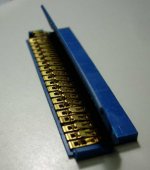azog
Experienced Member
Been trying to revive a PET 4032. As far as I can tell, the only major issue is with the keyboard.
The first step was to completely disassemble the keyboard to completely clean it out, and boy was it grubby.
But there is/was a lot of crud on the system board, and all of the problem areas seem to be directly over the keyboard driver circuits. Here are some blog entries with photos:
First assessment: http://www.azog.org/?p=833
Crud on the motherboard: http://www.azog.org/?p=900
Cleaning the motherboard: http://www.azog.org/?p=911
If you've not had the patience to follow my progress, the long and the short of it is that I've had to remove the resistor pack, a 74LS145 and the keyboard connector to be able to clean some of the crud underneath. I replaced the DIP packages with brand-new components, but re-used the male header. I might eventually go back and remove that, as some of the posts have nasty pitting on them, which may affect connectivity. But in the meanwhile, I can beep out all connections between the keyboard connector and the various points on the board, so electrically everything is sound.
My next step is to work on the actual keyboard connector. The corrosion was more damaging here, as several of the pins inside the female 1x20 connector have been eaten away and the wires are either in the process of breaking off, or have already broken off. I don't have any photos of this (yet), so I'm looking at replicating the connector cable between the keyboard and the motherboard.
It appears the card-edge connector on the keyboard side is in good condition, so I'm down to trying to find, or build a 1x20 cable, which brings me to the ultimate purpose of my post.
Does anyone know where to find, or perhaps even have a connector that's already wired? I can deal with the card-edge connector, since that's just a punch-down type, so I don't care what's on the other side, it's just the female 1x20 connector that's vexing me right now.
As a just-in-case scenario, the last thing to do would be to replace the 6520. I'm wary of trying to remove it intact, for fear of damaging the board itself, which is why I would opt to just destructively remove it. If I can find a 6520, I'll socket it, and at the very least, it'll replace the final component in the keyboard driver.
The first step was to completely disassemble the keyboard to completely clean it out, and boy was it grubby.
But there is/was a lot of crud on the system board, and all of the problem areas seem to be directly over the keyboard driver circuits. Here are some blog entries with photos:
First assessment: http://www.azog.org/?p=833
Crud on the motherboard: http://www.azog.org/?p=900
Cleaning the motherboard: http://www.azog.org/?p=911
If you've not had the patience to follow my progress, the long and the short of it is that I've had to remove the resistor pack, a 74LS145 and the keyboard connector to be able to clean some of the crud underneath. I replaced the DIP packages with brand-new components, but re-used the male header. I might eventually go back and remove that, as some of the posts have nasty pitting on them, which may affect connectivity. But in the meanwhile, I can beep out all connections between the keyboard connector and the various points on the board, so electrically everything is sound.
My next step is to work on the actual keyboard connector. The corrosion was more damaging here, as several of the pins inside the female 1x20 connector have been eaten away and the wires are either in the process of breaking off, or have already broken off. I don't have any photos of this (yet), so I'm looking at replicating the connector cable between the keyboard and the motherboard.
It appears the card-edge connector on the keyboard side is in good condition, so I'm down to trying to find, or build a 1x20 cable, which brings me to the ultimate purpose of my post.
Does anyone know where to find, or perhaps even have a connector that's already wired? I can deal with the card-edge connector, since that's just a punch-down type, so I don't care what's on the other side, it's just the female 1x20 connector that's vexing me right now.
As a just-in-case scenario, the last thing to do would be to replace the 6520. I'm wary of trying to remove it intact, for fear of damaging the board itself, which is why I would opt to just destructively remove it. If I can find a 6520, I'll socket it, and at the very least, it'll replace the final component in the keyboard driver.

